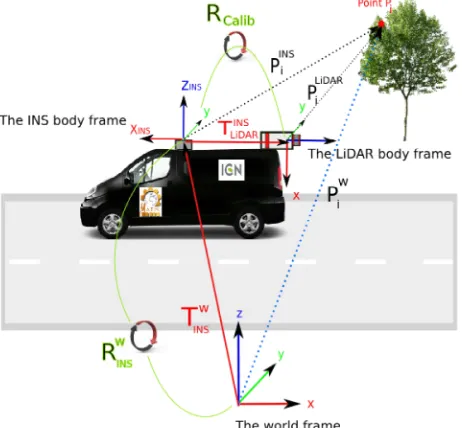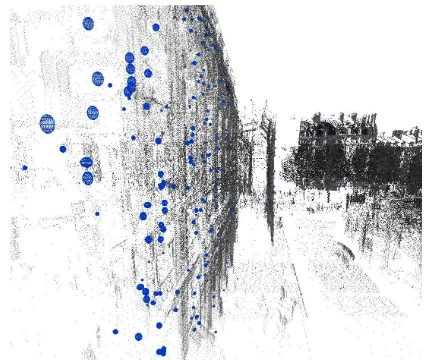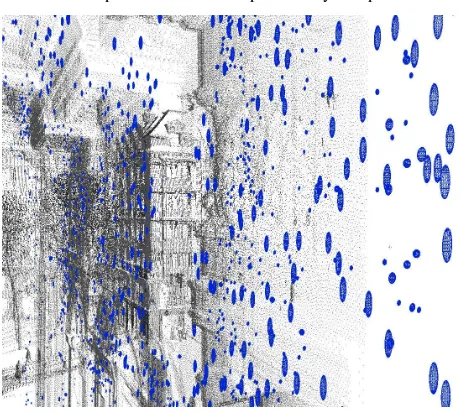UNCERTAINTY PROPAGATION FOR TERRESTRIAL MOBILE LASER SCANNER
Miloud Mezian*, Bruno Vallet*, Bahman Soheilian*, Nicolas Paparoditis*
*
Universite Paris-Est, IGN, SRIG, MATIS, 73 avenue de Paris, 94160 Saint Mande, France
Commission III, WG III/2
KEY WORDS:Mobile mapping, Laser scanner, Uncertainty propagation, Error ellipsoid
ABSTRACT:
Laser scanners are used more and more in mobile mapping systems. They provide 3D point clouds that are used for object reconstruction and registration of the system. For both of those applications, uncertainty analysis of 3D points is of great interest but rarely investigated in the literature. In this paper we present a complete pipeline that takes into account all the sources of uncertainties and allows to compute a covariance matrix per 3D point. The sources of uncertainties are laser scanner, calibration of the scanner in relation to the vehicle and direct georeferencing system. We suppose that all the uncertainties follow the Gaussian law. The variances of the laser scanner measurements (two angles and one distance) are usually evaluated by the constructors. This is also the case for integrated direct georeferencing devices. Residuals of the calibration process were used to estimate the covariance matrix of the 6D transformation between scanner laser and the vehicle system. Knowing the variances of all sources of uncertainties, we applied uncertainty propagation technique to compute the variance-covariance matrix of every obtained 3D point. Such an uncertainty analysis enables to estimate the impact of different laser scanners and georeferencing devices on the quality of obtained 3D points. The obtained uncertainty values were illustrated using error ellipsoids on different datasets.
1. INTRODUCTION
Mobile Terrestrial LiDAR System (MTLS) is an emerging tech-nology that combines the use of a laser scanner, Global Naviga-tion System (GPS), Inertial NavigaNaviga-tion System (INS) and odome-ter on a mobile platform to produce accurate and precise geospa-tial data on canyon urban. Much more detailed information has been acquired in comparaison with Airborne LiDAR Systems (ALS). (Olsen, 2013) discussed the key differences and similar-ties between airborne and mobile LiDAR data. The MTLS allows to obtain a large amount of 3D positional information in a fast and efficient way, which can be used in numerous applications, such as the object reconstruction and registration of system. In such applications, uncertainty analysis of 3D points is of great interest but rarely investigated in the literature. Consequently, it is impor-tant for users to know the uncertainty of MTLS and the factors that can influence the quality of 3D scanned data. Several studies have analysed the sources of uncertainties in MTLS, which are similar to those used by Airborne LiDAR System (ALS). More detail about ALS uncertainty sources was introduced by (Schaer et al., 2007). Others issues, related to sources of uncertainty af-fecting on the accuracy of the Mobile Terrestrial LiDAR point cloud are discussed in (Alshawa et al., 2007, Olsen, 2013, Leslar et al., 2014, Poreba, 2014) .
In general, the sources of uncertainty are divided into three main categories:
• navigation uncertainties : Here we have uncertainty of the absolute position and the vehicule orientation measured by INS in real time. The factors that affect the accuracy of the vehicule’s position depend : multipath, shading of the sig-nals caused by buildings and trees, and poor GPS satellite geometry (Glennie, 2007, Haala et al., 2008). Under good GPS conditions this uncertainty is about few centimeters,
however, under difficult conditions it can be up to few me-ters. In (Leslar et al., 2014), they have proved that under tightly controlled error conditions, the source of uncertainty in point cloud is domined by vehicule position.
• calibration uncertainties : Namely the uncertainties in the leverarm and in the boresight angles between scanner laser and the INS frame. The quality of the calibration parameters is usually known and depends on the calibration procedure (Le Scouarnec et al., 2014, Rieger et al., 2010).
• laser scanning uncertainties : The scanner laser measure-ments consist of two angulars and one distance.The factors affecting laser-target position accuracy are numerous such as the weather (humidity, temperature), properties of the scanned surface (roughness, reflectivity), scanning geom-etry (incidence angle on the surface) and scanner mecha-nism precision (mirror center offset) (Soudarissanane et al., 2008). These uncertainties are evaluated by the construc-tors.
This paper is organized as follows: Section 1 presents briefly the principles of geo-referencing of 3D point. Section 2 describes a complete pipeline that takes into account all the sources of uncer-tainties and allows to compute a covariance matrix per 3D point. The obtained uncertainty values were illustrated using error ellip-soids on different datasets.
In this work, the mobile data that we used was produced by the terrestrial mobile mapping vehicle Stereopolis II (Paparoditis et al., 2012) developped at National Geographic Institute (IGN). The laser sensor is a RIEGL VQ-250 that was mounted transver-sally in order to scan a plane orthogonal to the trajectory. It ro-tates at 100 Hz and emits 3000 pulses per rotation, which cor-responds to an angular resolution around 0.12◦
1.1 Mobile Terrestrial LiDAR formulas
Calculation of ground coordinates from Mobile Terrestrial Lidar System (MTLS) have been well documented in the literature (El-lum and El-Sheimy, 2002). As shown in Figure (1), the coordi-nates of pointPwi in the World frame can be calculated by
com-bining the information from the LiDAR, INS measurements and calibration
Figure 1: Concept of Mobile Terrestrial LiDAR System (MTLS)
The formula used to calculate the LiDAR point in the world frame is given in Equation (1) :
Pwi(t) =R w INS(t)P
INS i (t) +T
w
INS(t) (1)
Where :
• Pwi(t)represents the 3D coordinate of point P in the World
frame at time t and i is the index of the point.
• TwINS(t)is the position of the INS in the World frame at time
t.
• RwINS(t)is the rotation matrix between the INS body frame
and the World frame at time t :
RwINS(t) =R ENU
NED.R(θz(t), θy(t), θx(t)) (2)
– RENUNEDis the constant rotation matrix between the
North-East-Down coordinates and the East-North-Up coor-dinate frame :
RENUNED=
0 1 0
1 0 0
0 0 −1
(3)
– R(θz, θy, θx)is the rotation matrix between the INS
body frame and the World frame (in the North- East-Down coordinate system) withθx,θy,θzwhich
repre-sent the roll, pitch and yaw Euler angles given by the INS at time t :
R(θz, θy, θx)=R(θz)R(θy)R(θx) (4)
with :
R(θz) =
cos(θz) −sin(θz) 0
sin(θz) cos(θz) 0
0 0 1
(5)
R(θy) =
cos(θy) 0 sin(θy)
0 1 0
−sin(θy) 0 cos(θy)
(6)
R(θx) =
1 0 0
0 cos(θx) −sin(θx)
0 sin(θx) cos(θx)
(7)
• PINSi (t)is the position of the target point in the INS body
frame at time t :
PINSi (t) =Rcalib(Ω, ϕ, κ)PLiDARi (t) +T INS
LiDAR (8)
– Rcalib(Ω, ϕ, κ)is the constant rotation matrix between
the LiDAR body frame and the INS body frame.κ,ϕ
andΩare boresight angles.
– TINS
LiDARis the lever arm vector from the INS body frame
to the LiDAR body frame.
– PLiDARi (t)is the laser range vector between the LiDAR
and the target point p at time t :
PLiDARi (t) =
PLiDAR0 (t)
z }| {
X0LiDAR(t)
YLiDAR
0 (t)
Z0LiDAR(t)
+
ρ(t)cos(θ(t))sin(φ(t))
ρ(t)sin(θ(t))sin(φ(t))
ρ(t)cos(φ(t))
(9)
PLiDAR0 (t) : represents the mirror center offset of the LiDAR
instrument at time t (see Figure 2).
ρ(t) : is the LiDAR range at time t (see Figure 2).
θ(t),φ(t) : represents respectively the horizontal and verti-cal angles measured by the LiDAR in the LiDAR body frame at time t (see Figure 2).
Figure 2: (1) Center of LiDAR frame - (2) The mirror center offset of the LiDAR instrumentPLiDAR
The equation (1) can be rewritten as :
The above equation shows that the coordinates of pointPw i in the
World frame depends on 18 observations :
• TWINSx,T
W INSy andT
W
INSz defining the position of the INS in the World frame.
• θx,θyandθzare the roll, pitch and yaw Euler angles given
by the INS.
The MTLS use an odometer, GPS, and INS to determine the position (TWINSx,T
W INSy,T
W
INSz) and orientation (θx,θy,θz) of vehicule at time t.
• TINSLiDARx,T
INS
LiDARyandT
INS
LiDARzare the lever arm offsets from the INS body frame to the LiDAR body frame.
• Ω, ϕ, κare the boresight angles which align the LiDAR body frame with the INS body frame.
The lever-arm offset (TINSLiDARx, T
INS
LiDARy andT
INS LiDARz) and boresight anglesΩ, ϕ, κare determined through a calibra-tion procedure.
• X0LiDAR,Y0LiDARandZ0LiDARrepresent the mirror center off-sets of the LiDAR instrument given by the LiDAR scanner.
• ρ, θ andφrepresent the range and scan angles measured given by the LiDAR scanner.
Each of the 18 observations have an uncertainty, in the form of an standard deviation denoted byσ. We suppose that each of the measurements follows the normal (Gaussian) distribution. Know-ing the standart deviationsσof all observations (see Table 1), we applied uncertainty propagation technique to compute the covari-ance matrix of every obtained 3D point.
2. UNCERTAINTY PROPAGATION
In this section, we present uncertainty propagation technique which is based on the Gauss-Helmert general method. By applying this method, it is possible to compute the covariance matrix of a 3D point. The objective is to convert the covariance matrix given in terms of observations to a covariance matrix in terms of parame-ters.
2.1 General Methodology
The generic form of the Gauss-Helmert method presented by (Van-icek and Krakiwsky, 2015) consists in resolution of the following equation system :
F(Xˆ,ˆl) =0 (10)
whereXˆ is estimated unknown vector andˆlis estimated
obser-vation vector. The linearized form of equation (10) is given in equation (11) :
is the matrix of partial derivatives with
respect to unknowns, B = ∂F
is the matrix of partial
derivatives with respect to observations,w=F(X(0),
l(0))is the misclosure vector, X(0) and l(0) are intial values, δˆand rˆare residuals of unknowns and observations. The quantitiesA,Band
ware known, whileˆδandrˆare unknown.The unknowns
correc-tion vectorδˆand observations correction vectorrˆare :
ˆ
Finally, the general law of propagation of variances is applied. And, we obtain the covariance matrix of parameters :
Cx= (ATMA)-1 (14)
2.2 The covariance matrix of a 3D point
Table 1:Sources of uncertainty in MTLS
Sources of uncertainty Observations Uncertainties Values
Navigation uncertainties
TwINSx(t), Position X of the INS [m] σTwINSx Estimated from INS
Tw
INSy(t), Position Y of the INS [m] σT w INSy
Estimated from INS
Tw
INSz(t), Position Z of the INS [m] σTwINSz Estimated from INS
θx(t), INS Roll [degrees] σθx Estimated from INS
θy(t), INS Pitch [degrees] σθy Estimated from INS
θz(t), INS Yaw [degrees] σθz Estimated from INS
Calibration uncertainties
TINSLiDARx, LiDAR X Lever Arm [m] σTINSLiDAR x
0.001
TINSLiDARy, LiDAR Y Lever Arm [m] σTINSLiDARy 0.001
TINSLiDARz, LiDAR Z Lever Arm [m] σTINSLiDAR z
0.001
Ω, LiDAR Roll [degrees] σΩ 0.1
ϕ, LiDAR Pitch [degrees] σϕ 0.1
κ, LiDAR Yaw [degrees] σκ 0.1
Laser scanning uncertainties
X0LiDAR(t), mirror center offset in the X direction [m] σXLiDAR
0 0.001
Y0LiDAR(t), mirror center offset in the Y direction [m] σYLiDAR
0 0.001
ZLiDAR
0 (t), mirror center offset in the Z direction [m] σZLiDAR
0 0.001
ρ(t), LiDAR Distance [m] σρ 0.005 (Given by the constructor)
θ(t), LiDAR Horizontal angle [degrees] σθ 0.001 (Given by the constructor)
φ(t), LiDAR Vertical angle [degrees] σφ 0.001 (Given by the constructor)
where :
• Xˆi=
Xw i
Yw i
Zw i
:is the vector of unknowns of thePwi point.
• ˆli= [ρ θ φ X0LiDAR Y0LiDAR Z0LiDAR Ω ϕ κ TINSLiDARx
TINSLiDARy T
INS
LiDARz θx θy θz T
w INSx T
w INSy T
w INSz]
T:
is vector of observations of thePw
i point.
• A(3×3)=1: is the matrix of partial derivatives with respect to unknown.
• B(3×18) =
∂F
∂l l(0)
is the matrix of partial derivatives with
respect to observations.
• w=F(X(0),l(0))is the misclosure vector.
• ˆδ = −w,rˆ= 0are the unknowns correction vector and
observations correction vector.
• Cir is the covariance matrix of the observations of thePwi
point.
Cir=
σρ2 0 . . . 0
0 σ2
θ . . . 0
..
. ... . .. ...
0 0 . . . σ2Tw INSz
(15)
We assume that the observations are independent, so all non-diagonal values in the matrixCi
rare equal to zero. The covariance
matrix ofPwi can be computed by the covariance law :
Cix(3×3)=BCrBT=
σ2x σxy σxz
σxy σ2y σyz
σxz σyz σ2z
(16)
This covariance matrix of the pointPw
i can be depicted by an error
ellipsoid.
2.3 Error ellipsoid
From the covariance matrix of parameters (Equation 16) we can then calculate the eigenvalues (λ1 > λ2> λ3) and eigenvectors (e1,e2,e3). Each eigenvalue and eigenvector was used to con-struct the three axes of an ellipsoid. The eigenvectors give the directions of the principal axes of the uncertainty ellipsoid, and the eigenvalues give the variances along these principal axes. To create a 99.9 % confidence ellipse from the 3σerror, we must enlarge it by a factor of scale factors = √11.345. The ellip-soid is centered on the pointPw
i and the principal axes of this
ellipse are determined by the following equations :v1=s λ1e1, v2=s λ1e2andv3=s λ1e3.
The error ellipsoids are illustrated in the figures (3), (4), (5) and (6) :
Figure 4: Black : points cloud of the mobile terrestrial LiDAR , blue : error ellipsoids. An error ellipsoid every 300 points
Figure 5: Black : points cloud of the mobile terrestrial LiDAR , blue : error ellipsoids. An error ellipsoid every 150 points
Figure 6: Black : points cloud of the mobile terrestrial LiDAR , blue : error ellipsoids. An error ellipsoid every 100 points
3. CONCLUSION
In this paper, we have presented a uncertainty propagation tech-nique based on the general Gauss-Helmert method to compute the covariance matrix per 3D point and the obtained uncertainty values were illustrated using error ellipsoids on different datasets.
REFERENCES
Alshawa, M., Smigiel, E., Grussenmeyer, P. and Landes, T., 2007. Integration of a terrestrial lidar on a mobile mapping platform-first experiences. In: International Symposium on Mobile Map-ping Technology.
Ellum, C. and El-Sheimy, N., 2002. Land-based mobile mapping systems. Photogrammetric engineering and remote sensing 68(1), pp. 13–17.
Glennie, C., 2007. Rigorous 3d error analysis of kinematic scan-ning lidar systems. Journal of Applied Geodesy jag 1(3), pp. 147– 157.
Haala, N., Peter, M., Kremer, J. and Hunter, G., 2008. Mobile lidar mapping for 3d point cloud collection in urban areas, a per-formance test. The international archives of the photogrammetry, remote sensing and spatial information sciences 37, pp. 1119– 1127.
Le Scouarnec, R., Touz´e, T., Lacambre, J.-B. and Seube, N., 2014. A new reliable boresight calibration method for mobile laser scanning applications. The International Archives of Pho-togrammetry, Remote Sensing and Spatial Information Sciences 40(3), pp. 67.
Leslar, M., Hu, B. and Wang, J., 2014. Error analysis of a mobile terrestrial lidar system. GEOMATICA 68(3), pp. 183–194.
Olsen, M. J., 2013. Guidelines for the use of mobile LIDAR in transportation applications. Vol. 748, Transportation Research Board.
Paparoditis, N., Papelard, J.-P., Cannelle, B., Devaux, A., So-heilian, B., David, N. and Houzay, E., 2012. Stereopolis ii: A multi-purpose and multi-sensor 3d mobile mapping system for street visualisation and 3d metrology. Revue franc¸aise de pho-togramm´etrie et de t´el´ed´etection 200(1), pp. 69–79.
Poreba, M., 2014. Edge-based accuracy assessment and improve-ment of mobile laser scanning systems. Theses, Ecole Nationale Sup´erieure des Mines de Paris.
Rieger, P., Studnicka, N., Pfennigbauer, M. and Zach, G., 2010. Boresight alignment method for mobile laser scanning systems. Journal of Applied Geodesy 4(1), pp. 13–21.
Schaer, P., Skaloud, J., Landtwing, S. and Legat, K., 2007. Ac-curacy estimation for laser point cloud including scanning geom-etry. In: Mobile Mapping Symposium 2007, Padova.
Soudarissanane, S., Lindenbergh, R. and Gorte, B., 2008. Re-ducing the error in terrestrial laser scanning by optimizing the measurement set-up. In: XXI ISPRS Congress, Commission I-VIII, 3-11 July 2008, Beijing, China, International Society for Photogrammetry and Remote Sensing.


